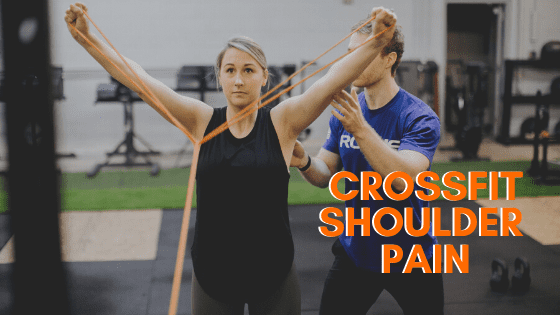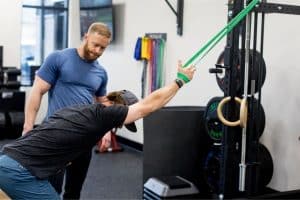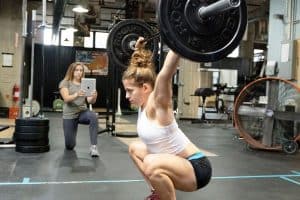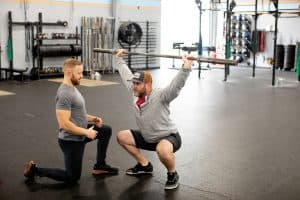
You get the notification for tomorrow’s WOD. Before you even look, your mind is already racing with thoughts like, “PLEASE, anything but thrusters!” or “Not pull-ups again!” Your shoulders are still begging for some relief after snatching popped up a few days ago. Essentially, you’re hoping for anything that will give them a break. CrossFit, in its constantly varied nature, never fails to highlight the movements you’re hoping to avoid. If you’re ready to clean up your CrossFit shoulder pain, check out these five key areas you might be overlooking!
Exercises for CrossFit Shoulder Pain
Rotator Cuff Strength
Anyone dealing with shoulder pain is inevitably given advice to strengthen their rotator cuff. The muscles comprising the rotator cuff act to stabilize the shoulder joint. So, it’s no secret that making these muscles more robust can help keep your shoulders healthy. However, this is only the beginning. If it were truly this simple, we’d all have strong, pain-free shoulders. Is it important? Absolutely. Is it the entire solution? Probably not. Strength in these muscles is a pre-requisite, but considering the following additional factors can help keep your overhead performance high.

Mobility: NOT just the shoulder
CrossFit demands sufficient mobility throughout our entire body, not just our shoulders. If we lack mobility in one area, our body will naturally seek to make up for it elsewhere. For example, let’s consider overhead squats or snatches. Many of us continue to struggle with shoulder pain here despite working on our overhead mobility and positioning. In some cases, your shoulder mobility and strength could be top-notch. Even so, they end up taking a beating from stiff ankles or tight hips, preventing you from reaching optimal positioning. These are often neglected areas of analysis for athletes dealing with shoulder pain.
For this reason, it’s important to consider both the athlete and movement as a whole. Very few movements in CrossFit isolate a single joint or muscle. So, it’s important we approach mobility in a comprehensive manner as well. This video demonstrates how limited ankle mobility in an overhead squat can lead to greater stress on the shoulders.
Horizontal Pulling
In CrossFit, we regularly see heavy doses of overhead movements and pressing work. From pull-ups, jerks, handstands, and wall balls, these patterns show up nearly daily in our WODs. On the other hand, we rarely see variations of horizontal pulling programmed. Regularly incorporating rowing variations (barbell, kettlebell, dumbbell, inverted, etc.) into your warm-ups, accessory work, or post-workout routine works to strengthen muscles that are bypassed with traditional programming. By working to address this asymmetry in training, we work to develop strength in opposing muscle groups. In turn, this assists in offloading the stresses applied to the shoulder complex during typical training. Above all, this helps keep the nagging pains that sneak in when overhead or pressing volume gets high to a minimum.
Strict Gymnastics Strength
When it comes to gymnastic skills in CrossFit, it’s tempting to dive in quickly. Butterfly pull-ups, kipping handstand push-ups or muscle-ups are often more appealing than their strict counterparts. When executed properly, these allow you to move more quickly and efficiently through the WOD. However, what we often lack in our transition to more dynamic movements is a strong foundation of strict strength.
For example, if we lack the requisite strength to perform at least one strict pull-up, adding in momentum with kipping (especially if kipping mechanics aren’t on point) can redirect greater forces through the shoulders. This can mean disaster for shoulders that already lack sufficient strength to control the movement without momentum. We wouldn’t run before we could walk or crawl. So, on a similar note, we should take the time to master strict strength before adding in a dynamic component. If you’ve noticed sore, painful shoulders following high-volume gymnastics workouts, it may be time to take a step back. You may need to work on building your strict capacity and dive deeper into your mechanics.
Onward Charlotte team member Dr. Zach Long discusses this more in this video:
Comprehensive Analysis of Shoulder Movements
The sport of CrossFit as defined by coach Greg Glassman “not a specialized fitness program but a deliberate attempt to optimize physical competence in each of ten recognized fitness domains. They are Cardiovascular and Respiratory endurance, Stamina, Strength, Flexibility, Power, Speed, Coordination, Agility, Balance, and Accuracy.”
Given the stark difference between traditional fitness routines, having a trained eye break down and analyze the movements required within a CrossFit box is crucial to managing potential injuries and keeping performance high. Maybe you’re noticing your shoulders always flare up after kipping. Maybe you’re consistently left extra sore after cleans and jerks despite coaching feedback and your own efforts. If so, schedule an assessment with our team of physical therapists to dive deeper into potential limitations that may be holding you back!

Recent Articles
Why Early Intervention Physical Therapy Accelerates Your Recovery

What to Expect at Your First Physical Therapy Session?

How to Choose a Physical Therapist

The Top 5 Misconceptions About Physical Therapy

The Complete Guide to Physical Therapy


